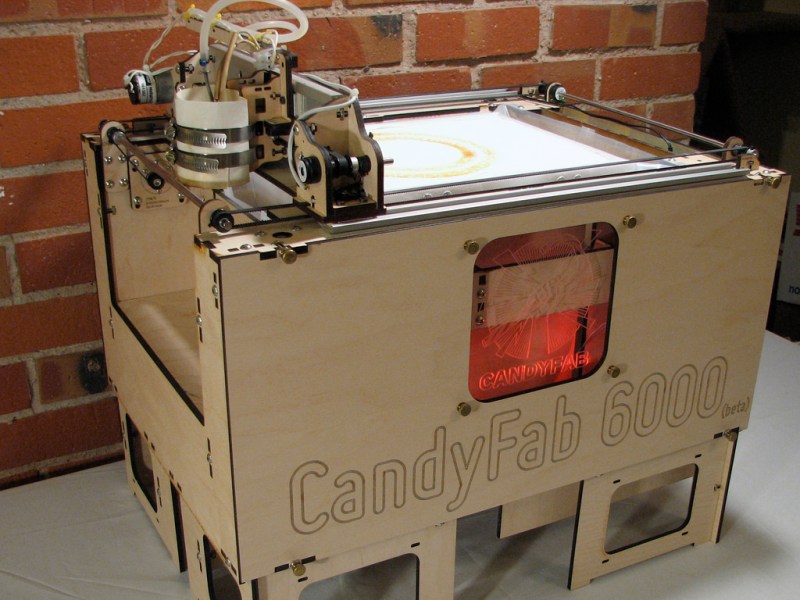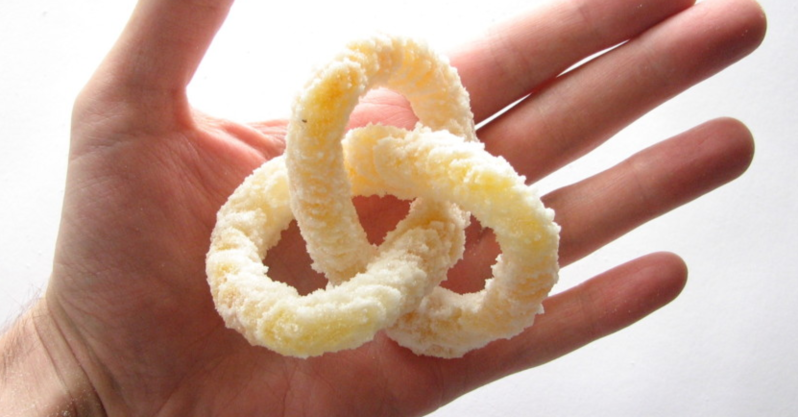About a decade ago [Windell Oskay] and [Lenore Edman] spun out of Evil Mad Scientist Laboratories to work on CandyFab, an inexpensive 3D printer that used sugar as its medium. Wondering what happened to CandyFab? It’s been nearly that long since we last wrote about their work and Maker technology has moved on; nowadays 3D printers run the gamut from very inexpensive to production ready. The CandyFab project and nascent company are now shuttered, but there is a epilogue with some interesting lessons.

First of all, the saga of the CandyFab series of printers (above on the same page) is worth a read. Some of what these machines were capable of is still quite impressive by modern standards. Sure your Monoprice Mini Delta may be easy to use, fully assembled, functional when you take it out of the box, and quiet. But what if you need to print something up to 8.5″ x 11″ x 17″? The CandyFab 5000 can do that. Or even a humongous 24″ x 13.5″ x 9″? The CandyFab 4000 can do it, and for a measly $37 (if you printed a solid cube exactly the size of the build volume)! Sugar may have downsides but it’s still a pretty clever medium for some uses.
CandyFab credits the rise of MakerBot coupled with the complexity of iterating from a pile of “surplus junk” (their words) to something kitable. Reading their post-mortem brings to mind familiar problems from today’s hardware world. A spike of fantastic early publicity lead to the need to handle press while rapidly iterating from the aforementioned surplus parts to a reliable and manufacturable design. Then the complexity of balancing a day job and other side projects with the prospect of CandyFab as a business. Ultimately the need for the project in the first place (accessible inexpensive 3D printers) was alleviated by the market and the project came to a graceful close.
Give the post a read, we’re sure you’ll learn something!
















A really good self-analysis although the part about VC funding was painful to read. “While we had personal access to many of the venture capitalists here in Silicon Valley…” followed by “… it’s hard to imagine that anyone would fund a project run by people who hadn’t already quit their day jobs for it.” Getting access to VC is usually the hardest part, and it sounds like they had it. Yeah, you do have to quit your day job, but with VC that’s a lot less scary because you get some time to pay the bills while you do your thing.
Access to the capital isn’t the same thing as a reasonable chance of success. If at the end of the day you don’t have something that someone (a lot of someones) want to buy then you are just wasting time and money. They learned what they could learn and then moved on. Some projects are about the journey and never reach a destination.
I worked for a couple of companies supported by VC years ago.
I think their biggest obstacle was “they had a good idea”, but wanted it to be a stand-alone success, when they should have licensed their idea to others to make their (existing) products better.
I am not saying/implying that applies in this case of CandyFab.
i mean the thing is super neat – i saw one of the originals at maker faire back in the day. but did anyone ever really think this could be something other than an art project/novelty? the parts are less useful than even the shittiest plastic FDM, and the “candy” is basically inedible.
Here on HACK-a-day “why” is almost always the wrong question to ask. It’s as often about the journey as the destination. But… Why? I don’t get it.
Their first version was a great accomplishment. The correct response is to be impressed. But.. it was “unmanufacturable” so they made an immense effort to come up with a manufacturable version with plans to sell it as a kit. By how was that supposed to work?
Where is the market for a device that produces large objects out of melted sugar? Are these objects supposed to be candy? I think they need to use more than just sugar for that. How much pure sugar can a person ingest before feeling ill? I know I can’t eat that much of it! Are they supposed to be knickknacks? Do melted-sugar objects keep well on shelves? Do they absorb water from the air? Do they attract ants?
The only thing I can come up with is cake decorations. I think there scale was way off for that. For cake toppers I would think they would want smaller objects with better precision and more detail. I think they would want something closer to today’s standard 3d printers in that regard.
They make the comparison that if they had stuck with it they would be just another 3d printer company. I don’t get that though. While I don’t really understand the use case for their product I’m pretty sure it is not the same as the use case for a product that spits out plastic.
I think that rather than try to make a manufacturable version it would have made more sense to keep going with the re-used parts version. Instead put the effort into trying to use more than just sugar to make something more candy like, increasing precision and perhaps making a scaled down version. That may have eventually resulted in something that was worth quitting the day jobs to make a manufacturable version of. Or.. maybe just another direction for other hobbyists to emulate and eventually contribute their own ideas too.
Either way… cool hack even if I’m not sold on the business idea.
“How much pure sugar can a person ingest before feeling ill?”
It depends on the individual but generally quite a lot. That doesn’t mean you should go ahead and do it. There’s evidence than consuming large quantities on a regular basis can cause severe health issues in some people.
I don’t have the references to hand but you should be able to find them easily enough. Just watch out for the woo-woo merchants, and don’t use wikipedia either. It’s wildly inaccurate on healthcare issues with what seems like every food fetishist with a computer stirring the pot.
I wonder if the principle would work with a finer grade of sugar? It’d be interesting to use icing sugar in thin layers to improve the resolution. You could also possibly use a diode laser to fuse the sugar? Perhaps they tried and rejected that?
One use that springs to mind (assuming you could improve the resolution) would be to make soluble patterns for investment casting. Perhaps there’s more straightforward approaches to that?
Interesting write-up of something I’d either never seen or forgotten about
I was wondering that same thing – if a person could use a low cost laser diode instead of a heat gun.
Rather than making parts for the purpose of eating them, I wonder if there’s any casting processes that could be used. Like lost wax casting, but you start with a sugar part instead of wax.
It’s probably better, if not safer, than eating it :)
I’ve wondered about the laser and casting questions. Visible light lasers could have problems with plain old white sugar. I have no idea about the optical characteristics of sugar in the IR spectrum. The grain size of the sugar is probably the fundamental limiting factor.
Being water soluble could make for an interesting casting process in materials that can’t tolerate heat. Maybe a silicone mould or maybe even wax.
I’m not sure what you could cast with a wax mold, perhaps some sort of slip material as long as it can harden despite the wax being a moisture barrier.
Powdered “icing” sugar is typically a mixture of sugar with anti-caking agents (e.g., corn starch). While it can be fused, it doesn’t result in something that makes good solid candy.
Also, grain size of the sugar particles wasn’t really one of the technology limits.
Soluble casting models is definitely one of the things that kept coming back as an interesting application.
The comments following your comment, made me consider a 3D printer that would use icing sugar spread in small layers and fused by a laser.
I have a project that could benefit from a modified version of their mechanicals (not for printing in sugar).
Since they’re not pursuing it as a product, are their design files available anywhere? I did a quick search and couldn’t find anything obvious…
One minor issue .. the Monoprice mini delta is a remarkable little machine, but quiet it ain’t. We have five printers in our prototyping cluster (minindelta, two Monoprice Ultimates, a Robo R1+ amd a Creality CR-10 S5), and the litrle delta makes the biggest noise.
Printing water soluable casting parts for lost sugar casting? Spray with a thin layer of wax, encase in ceramic slurry, heat to cure & then flush w water.